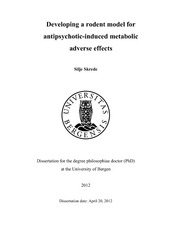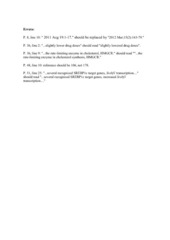| dc.contributor.author | Skrede, Silje | en_US |
| dc.date.accessioned | 2013-01-08T12:39:12Z | |
| dc.date.available | 2013-01-08T12:39:12Z | |
| dc.date.issued | 2012-04-20 | eng |
| dc.identifier.isbn | 978-82-308-2009-4 | en_US |
| dc.identifier.uri | https://hdl.handle.net/1956/6250 | |
| dc.description.abstract | Antipsychotic agents represent efficient therapy for serious psychiatric disorders, particularly schizophrenia, but also bipolar disorder, and are used by millions of patients worldwide. Metabolic adverse effects of antipsychotic drugs are thought to contribute significantly to the fact that life expectancy among schizophrenic patients is reduced with several decades. In particular, the so-called second-generation antipsychotics – most notably clozapine and olanzapine - significantly increase the prevalence of obesity, dyslipidemia, and type 2 diabetes. After initial cell culture experiments in our lab demonstrated that antipsychotic drugs activate lipid biosynthesis through the transcription factor SREBP, we set out to elaborate our findings in various preclinical model systems. Exposing glial-like and neuronal-like cultured cells to different antipsychotic agents, we showed that antipsychotics activated the expression of several SREBP-regulated genes encoding key enzymes in lipid synthesis with varying potency between the different drugs. The effects were much more potent in glial-derived than in neuron-derived cells, which is interesting in light of the fact that glial cells produce the bulk of lipids, essential in myelination and synaptic development, in the central nervous system. We then treated female rats with the metabolically potent antipsychotic agent olanzapine or with aripiprazole, which is considered metabolically neutral in humans, for two weeks. Olanzapine induced marked increase in food intake and significant weight gain in rats. By including olanzapine-treated rats with restricted access to food, which did not gain weight, we demonstrated that weight gain primarily relies on increased food intake. Aripiprazole, included as a negative control, yielded significant increase in food intake and weight gain. Notably, increased serum triglyceride levels were detected in all olanzapine-treated rats, independent of weight gain, while serum triglyceride elevation was not present in rats treated with aripiprazole. In olanzapinetreated rats, serum triglyceride increase was accompanied by lipogenic activation in peripheral metabolic tissues, particularly in visceral adipose tissue. In this 2-week experiment, we also included one treatment group receiving the modified fatty acid tetradecylthioacetic acid (TTA), a lipid-lowering agent, and one group treated with a combination of olanzapine and TTA. Despite olanzapine-induced weight gain in the olanzapine-TTA treatment group, TTA cotreatment led to significant reduction in lipid levels in serum and liver. In a follow-up experiment spanning 8 weeks, serum and lipid levels were similarly reduced in all rats receiving TTA, either as monotherapy or in combination with olanzapine or clozapine, in spite of weight-potentiating effects. In the liver, we found that TTA induced the transcription and activity of the key oxidative enzymes ACOX1 and CPT2, and downregulated transcription of HMGCR, the rate-limiting step in cholesterol synthesis. The effects of olanzapine monotherapy on food intake and weight gain wore off approximately three weeks into the experiment, and serum triglycerides were not elevated in olanzapine-treated after 8 weeks of treatment. Clozapine, unlike in humans, did not induce weight gain. We concluded that improved dosing regimens are necessary in order to maintain dysmetabolic effects of antipsychotic in rat in the long term and thus increase the relevance of this animal model. The concomitant weight gain potentiation and lipid-lowering effects of TTA, on the other hand, further supported the presence of independent mechanisms regulating body weight and lipid levels. These parameters may not be fully disconnected, however, as one potential mechanism suggested by us to underlie favourable lipid values was increased adipose tissue mass, providing storage capacity for surplus lipids. | en_US |
| dc.language.iso | eng | eng |
| dc.publisher | The University of Bergen | eng |
| dc.relation.haspart | Paper I: Fernø, J., Skrede, S., Vik-Mo, AO., Håvik, B. & Steen, VM. (2006) Drug-induced activation of SREBP-controlled lipogenic gene expression in CNS-related cell lines: marked differences between various antipsychotic drugs. BMC Neuroscience 7:69, October 2006. The article is available at: <a href="http://hdl.handle.net/1956/6249" target="blank">http://hdl.handle.net/1956/6249</a> | en_US |
| dc.relation.haspart | Paper II: Skrede, S., Fernø, J., Vázquez, M. J., Fjær, S., Pavlin, T., Lunder, N., Vidal-Puig, A., Diéguez, C., Berge, RK., López, M. & Steen, V. M. (2012) Olanzapine, but not aripiprazole, elevates serum triglycerides and activaties lipogenic gene expression in female rats. The International Journal of Neuropsychopharmacology 15(2): 163-179, March 2012. Full text not available in BORA due to publisher restrictions. The article is available at: <a href="http://dx.doi.org/10.1017/S1461145711001271" target="blank"> http://dx.doi.org/10.1017/S1461145711001271</a> | en_US |
| dc.relation.haspart | Paper III: Skrede, S., Fernø, J., Bjørndal, B., Brede, W. R., Bohov, P., Berge, R. K. & Steen, V. M. Antipsychotic-induced metabolic adverse effects and pharmacological intervention: challenges with the female rat model. Full text not available in BORA. | en_US |
| dc.title | Developing a rodent model for antipsychotic-induced metabolic adverse effects | en_US |
| dc.type | Doctoral thesis | |
| dc.rights.holder | Copyright the author. All rights reserved | |

